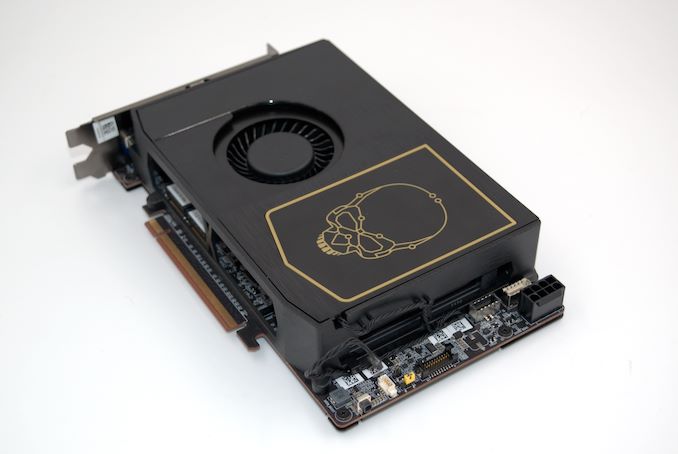The Intel NUC12 Extreme Dragon Canyon Preview: Desktop Alder Lake Impresses in SFF Avatar
by Ganesh T S on February 24, 2022 10:45 AM EST- Posted in
- Systems
- Intel
- NUC
- NUC12
- Dragon Canyon
Miscellaneous Aspects and Concluding Remarks
Desktop PCs are often used for media playback and double up as HTPCs in certain cases. While the fan noise / bulk prevent the NUC Extreme line from being used as dedicated HTPCs, the video decoding capabilities are very important - particularly if the end user finds it acceptable to add a discrete GPU for post-processing.
The Intel UHD Graphics 770 exposes hardware decoding capabilities for almost all commonly used codecs - MPEG2, VC1, WMV9, H264, HEVC, VP9, and AV1. For HEVC, the GPU also supports decode of 4:2:2 and 4:4:4 10-bit and 12-bit streams.
Moving on to the power consumption aspect, we ran the AIDA64 System Stability Test with various stress components, as well as the artificial power virus test involving Prime95 and Furmark for determining load power. The maximum sustained power consumption at the wall was recorded.
| At-Wall Power Consumption (Lower is Better) |
||
| Intel NUC12DCMi9 (Dragon Canyon) |
Intel NUC11BTMi9 (Beast Canyon) |
|
| Load (Max. / Sustained) | 336W / 127W | 167W / 120W |
| Idle | 36W | 28W |
The sustained power consumption is largely in the same ballpark for both NUCs. However, the instantaneous spikes are quite high for the Dragon Canyon, particularly when fresh workload segments start.
Looking Forward...
The Dragon Canyon NUC brings socketed desktop processors to the NUC lineup for the first time. It also brings native 10Gb Ethernet to the lineup. Alder Lake brings hybrid processors with performance and efficiency cores, and that delivers significant benefits. While these improvements are impressive from the viewpoint of a SFF machine, the power consumption puts a slight dampener.
In terms of internals, the Dragon Canyon's updates are also tempered by over-reliance on the PCH for almost all of the I/Os of the PC. In comparison, the Beast Canyon NUC had a better spread with the Thunderbolt 4 ports directly off the CPU. Given that the Alder Lake platform supports USB 3.2 Gen 2x2, a couple of the 20Gbps ports would have also been welcome on the Compute Element.
On the baseboard side, we would like to see support for PCIe lane bifurcation making a comeback. The chassis itself has not essentially changed - just the alteration of a Type-A port in the front to Type-C. This means that many of the drawbacks that existed in Beast Canyon (such as the user-unfriendly nature of the recessed ports) continue to exist in the Dragon Canyon.
Intel has put in significant effort to pack the capabilities of the Dragon Canyon NUC in a 8L platform. However, a bit of relaxation on the volume front would have been welcome - particularly from the viewpoint of making the installation of the Compute Element into the chassis easier. Hopefully, these issues will get fixed in a future iteration of the NUC Extreme.
This article provided a preview of the capabilities of the Dragon Canyon NUC. In an upcoming piece, we will look into the gaming chops of the machine with a discrete GPU installed.












38 Comments
View All Comments
vegemeister - Friday, February 25, 2022 - link
36 W idle power lol. As much as an ultraportable laptop running flat out. Switching to a socketed desktop part was clearly a mistake.CyrIng - Friday, February 25, 2022 - link
Should we rather say 8 Pcore + 8 Ecore, short 8P + 8E , for a hybrid processor.James5mith - Friday, February 25, 2022 - link
Why is the best slot performance wise (CPU connected one on the back) the worst from a cooling perspective? That makes no sense.You can put in a PCIe5.0 NVMe drive in this slot! But you can't run it near capacity or it will melt.
thestryker - Friday, February 25, 2022 - link
All of the M.2 slots are Gen4.FXi - Friday, February 25, 2022 - link
Sorry a small/modest liquid or even more silent cooling solution can be done in this size. And the soldered wifi is a turnoff because those standards change every 2-3 years far less than the lifespan of the rest of the system. For what this costs, and with how easy it is to build your own, they really have to tick all the user friendly and quiet boxes just right or their market is going to be pretty small.bwj - Saturday, February 26, 2022 - link
I really hate the case but I really like the compute element. With integral 10ge and dual TB ports it's quite nice. Would love to see another OEM putting the compute element into a simpler chassis, hopefully at a lower price. I built an i7 rig, complete with storage and memory, for $1300 but then I had to add TB and 10ge expansion cards. Would prefer an integrated package.drbartsimpson - Wednesday, March 9, 2022 - link
Would like to see a comparison with the just announced Mac Studio with the M1 UltraDug - Friday, March 11, 2022 - link
"In terms of internals, the Dragon Canyon's updates are also tempered by over-reliance on the PCH for almost all of the I/Os of the PC. In comparison, the Beast Canyon NUC had a better spread with the Thunderbolt 4 ports directly off the CPU. Given that the Alder Lake platform supports USB 3.2 Gen 2x2, a couple of the 20Gbps ports would have also been welcome on the Compute Element."You guys never test any of the ports, wifi, sound, or storage, so I guess we'll never know if it actually makes any difference in the real world.
Also from the diagram, isn't the tb4 coming off of the cpu?